DIAMOND COLOR
LEARN ALL ABOUT THE COLORS OF A DIAMOND
This post contains affiliate links. If you use these links to buy something I may earn a commission. Thanks! As an Amazon Associate I also earn from qualifying purchases.
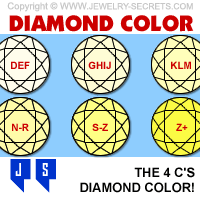
In their purest form, diamonds are all white by nature. White color doesn’t actually mean that the diamonds are physically white in color (like a piece of paper), but that they are colorless, or have no color in them. They are virtually free of any color whatsoever.
Mother nature is not perfect though and as diamonds grew in the earth billions of years ago, nitrogen found its way into the crystallization process. Nitrogen is the common element that gives most diamonds their colors (like yellow, brown and gray).
The common color and most preferred color on the market today is of course white, which makes up 2 main categories called “colorless” and “near colorless“.
Let’s take a closer look at the diamond color guide as devised by GIA’s standards back in the early 1950’s so you can see where they fall.
Diamond Color Guide:

Not only do common diamonds have a yellow hue like the classic color chart shown above, but diamonds can also can have brown hues to them like this:

And diamonds can also have gray hues like this:

The color charts show the same grading scale (D-Z + fancy), but just in different hues found in diamonds today: yellows, browns, and grays.
There are 23 different letter grades in all. Take note that there is no A, B, or C in diamond color because GIA didn’t want to confuse the public with other grading systems or make people feel like all the other diamond colors were inferior to A.
So D is at the top of the chart and Z is at the bottom. Anything below Z (Z+) is considered a fancy colored diamond (which we’ll get into later in this post).
For now, I’ll concentrate on the colors common on the market today (D-J).
D Color:
D color is perfect color. Nothing gets a higher color grade than D. D color is void of any color when viewed from any angle, side view or even upside down.
D is very rare and very expensive (it gets the biggest jump in price). Most D colored diamonds don’t hit the market and are considered collector’s items.
D color (as well as all the colorless diamonds D-F) are very bright and very white.
This brightness tends to make the entire body of the diamond sparkle more. Colorless is stunning. If you placed a D colored diamond up against an H colored diamond, you would truly see a difference.
It will open your eyes.
Most people don’t really look at the color of a diamond much until you can actually see them side by side. But once you see this color difference, you are hooked.
I love colorless diamonds and highly recommend them.
E Color:
E color is one step below D and almost impossible to tell the difference between them (which is why I always advise buying E). After all, you are comparing a colorless diamond to a colorless diamond. Even an expert will not be able to tell the difference between the two unless they viewed the stones face down, in the right light, and even then a set of master color grading stones is probably needed (master stones are expertly picked diamonds with the correct color ranges that all other diamonds are compared to).
E color to me, is the most perfect color there is. It’s the one diamond color that I love to show and sell.
Buy E, you won’t regret it (as in these e colored diamonds here).
F Color:
F color is the last color in the colorless range. F is still a pure white diamond with no traces of color. Only when viewed upside down can experts distinguish F from D or E.
The thing to note about F is that F (like all colors) is not one single color. F is a range of colors that falls between E and G colors. So an F colored diamond could look almost identical to an E color, or, it could also look exactly like a G colored diamond.
Every diamond is different and every diamond color will fall into the color at different positions.
Any diamond F color or higher is going to be exquisite and very white and very bright.
Do note that this also depends on the clarity of the diamond and the cut of the stone as well. But if you view colorless diamonds up against near colorless, you can usually see a striking difference.
Colorless is worth every penny.
G Color:
G color is at the very high end of the near colorless range (G and H are considered “fine white” colors).
The great thing about G is the fact that it’s still a white colored diamond and most people can’t tell the difference between a pure white diamond and a fine white diamond anyway. White is white, and unless you put it up against an E color or an I colored diamond (2 grades higher or lower), you probably wouldn’t ever notice the difference.
The near colorless range is the most common range on the market (G, H, I and J). Near colorless is a more affordable range and you still get a great looking color. It makes a great compromise.
Not until you get into J, K and L colors do you really start to notice the yellow hues.
Remember, G is a color range, just like all the other colors. There is no one exact color grade. It’s a range between two others. One G color could sit next to an F color, while another G color could sit closer to an H color.
To test this, compare a couple of G colored diamonds side by side. Chances are, one stone may look whiter than the other.
This color range chart below shows how 2 G colored diamonds could actually be two totally different hues…
Diamond Color Range:

Do keep in mind that this color variance is very slight and even experts with master color grading stones may have to compare the different shades to see where they all fit in.
This is why you’ll normally have to compare colors of at least 2 grades apart just to see any differences between them. You’ll have to compare an E to a G, or a G to an I color to spot the color changes.
H Color:
H color is still considered a fine white diamond color. When mounted in an engagement ring or any jewelry, H colors will generally appear colorless when face up (looking directly down into the stone).
H color is the lowest color grade that I personally would recommend. Beyond H color is when diamonds will start to show faint traces of yellow, brown or gray tones.
An untrained eye may not see these traces of color, but if you look at enough diamonds, you’ll start to see the yellow tints and darkness that lower color ranges bring.
Stick with at least an H color or higher, and you’ll get yourself a nice bright, white stone.
I Color:
I color is probably the most common diamond color on the market (most diamonds have a yellow tint). I color is everywhere. And that’s because it’s still a near colorless diamond and when mounted, it still hides most of its color.
I color is great for most types of jewelry; earrings, pendants, bracelets, but for an engagement ring (the showpiece), I would recommend a higher color (colorless if you can).
Engagement rings are the one item that gets the most scrutiny. It’s the one diamond that everyone wants to see and see close up. People will grab your finger for a closer view. They want to be bedazzled with the sparkle and beauty.
A diamond of higher color (white color), will give you that extra edge. That extra whiteness and pizazz.
If your fiancée puts her colorless (D-E-F) diamond up against her girlfriend’s diamond ring (I-J color), there should be a huge difference. The colorless ring will look ultra shiny and clean and the other ring may appear darker and often stained or dirty. The usual comment you get from the I-J colored diamonds are “Oh, I just need to clean my diamond”… That may be the case, but color has a lot to do with the way a diamond looks.
I color is great for earrings and pendants (probably makes up for 90% of them), but for a diamond ring, I would strive for something whiter.
J Color:
J color is at the bottom end of the near colorless range. J color borders on faint yellow diamonds.
Take a look at the diamond color chart again…

J color will often look slightly yellow, dark or even brown.
Set into a yellow gold mounting will really help hide this slight yellow color, but to me, they always tend to look darker and stained.
Some people prefer a “warm” diamond color. Some think it adds beauty into the stone. But for most, including me, I like a bright white diamond. I find it more appealing and beautiful.
Please note that if you’re buying a larger carat weight (1.00 carat or larger), color will be more obvious to detect. In diamonds .25 carat or smaller, color isn’t a big deal. It’s hard to detect any color changes in smaller stones. But large engagement ring diamonds will generally be better off with at least H color or higher.
K – L – M Color:
K, L and M make up the faint yellow color ranges. When you look at diamonds in this color range you will certainly see the yellow hues. In most instances, it’s pretty obvious and almost distracting.
Even set into a yellow mounting, the diamond will look even more yellow. And if you set a diamond like this into a white gold mounting, the contrast could be a night and day difference.
N, O, P, Q, R, S, T, U, V, W, X, Y, Z Color:
N-Z color (N, O, P, Q, R, S, T, U, V, W, X, Y, Z) is where you will really see a lot of color in the diamond. P color really looks like, well, P color. The demand for stones that are this shade are rare and I’ve seen diamonds sit in the jeweler’s showcases for years. Usually the only way to turn these stones over is to discount them greatly.
What’s funny about color is that some people care a lot about color, and others could care less. White, brown, yellow… They just want a big diamond.
If quality is something you’re looking for in a stone (like the one for an engagement ring), then white is the way to go (like these diamonds here at James Allen).
Cut affects Color:
The way a diamond is cut (diamond cut) affects the color of a diamond as well.
A shallow diamond (spread stone), will lighten the color of the diamond, while a deep stone (with a deep pavilion) will enhance and darken the color more.
Keep this in mind if you’re buying a diamond that’s I or J in color. It could look more yellow than it really is.
Fluorescence Affects Color Too!
Some diamonds (1 out of 10) have a natural phenomenon called fluorescence. Fluorescence is where a diamond will actually glow in the dark under an ultraviolet light (think black light). Some will glow blue, some yellow, some red. This ghostly glowing color can also affect how a diamond looks in normal lighting. If the diamond has strong fluorescence (fluorescence is listed on a certified diamond report), it can actually make the diamond look cloudy or foggy.
Some people mistake this cloudiness for color and think that the diamond appears whiter, when in fact, it’s not a good trait to have and it can diminish the beauty, sparkle and value of a diamond.
This is where the term blue white diamonds come from…
Blue White Diamond Color:
Blue-white is an old term that’s not used much today (it’s frowned upon by the jewelry industry).
The term blue-white is misleading and the FTC states clearly that it can only be used to describe a diamond that has a blue fluorescence.
Blue-white used to be a term to describe colorless diamonds with beautiful flashes of blue light in it, but not anymore. If any jeweler says “This diamond has blue-white color…” I would walk away and not buy from that jewelry store.
Blue-white is not a good description for any diamond. Do not be fooled.
Evaluating Diamond Color:
Gem labs (like GIA), use master color grading stones to evaluate and assign colors to diamonds when grading them. Viewing the diamonds in a controlled laboratory in neutral lighting conditions, face down, is the best way to judge color.
Most jewelers though, do not have the luxury of these controlled settings and use colorimeters or spetrophotometers to analyze color instead.
These expensive instruments are pretty precise, but never quite perfect. The eye is still the best way to perceive color and evaluate color grades.
Fancy Colors:
Not all diamond colors are bad. In fact, some diamonds with color are way more expensive than their white alternatives of the same clarity, cut and carat weight.
Diamonds usually always have some traces of color in them, but when that color is deep, vivid and intense, it falls into a color range appropriately called “fancy color“.
Fancy color is beyond the color charts, it’s any diamond color past Z (labeled Z+, see chart above for an example of brown and blue fancy colored diamonds).
Diamonds can come in all shades of the rainbow (except emerald green), from blues, greens, yellows (like canary yellows), oranges, pinks, purples, reds, browns, grays, violets, blacks and of course whites.
If you’ve been to the smithsonian institute you’ve probably seen the most famous 45.52 carat diamond in the world; The Hope diamond. The Hope diamond is a large blue diamond that actually has a red fluorescence glow to it. Worth an estimated value of 250 million, the Hope creates an exhibit you just have to see.
Sadly, most fancy colored diamonds are not this large in carat weight, or this vivid in color. Most fancy colors are often only 20 points or smaller in size.
One of the most common of the fancy colors is brown…
Brown Diamonds:
Brown diamonds have become very popular in the last 20 years or so. With effective marketing and wonderful pieces of jewelry being designed, brown diamonds have found their way into homes and our hearts.
With great names like: chocolate, champagne, cognac, coffee and cinnamon, Brown diamonds have made their mark on the market and are here to stay.
Blue Diamonds:
Blue diamonds have worked their way into the jewelry stores as well. Over the last ten years, beautiful blues and greens (tropical colors) have been opening up whole new exciting lines for customers. And having exotic names like carribean blue diamonds just makes them all the more appealing.
I love blue diamonds and would highly recommend them… Just not for an engagement ring. :)
Black Diamonds:
One of the most surprising diamond colors to hit the market lately are black diamonds. Black diamonds look more like black onyx gemstones than they do diamonds. They lack the transparency that diamonds are known for. Most are jet black and have no sparkle, just reflection coming from their facets. Being this dark and black, clarity is not an issue for these diamonds.
Black diamonds do make one of the most striking combinations of jewelry when set side by side with white diamonds. They look rich, beautiful and striking.
See image below of chocolate diamonds, blue diamonds and black diamonds…
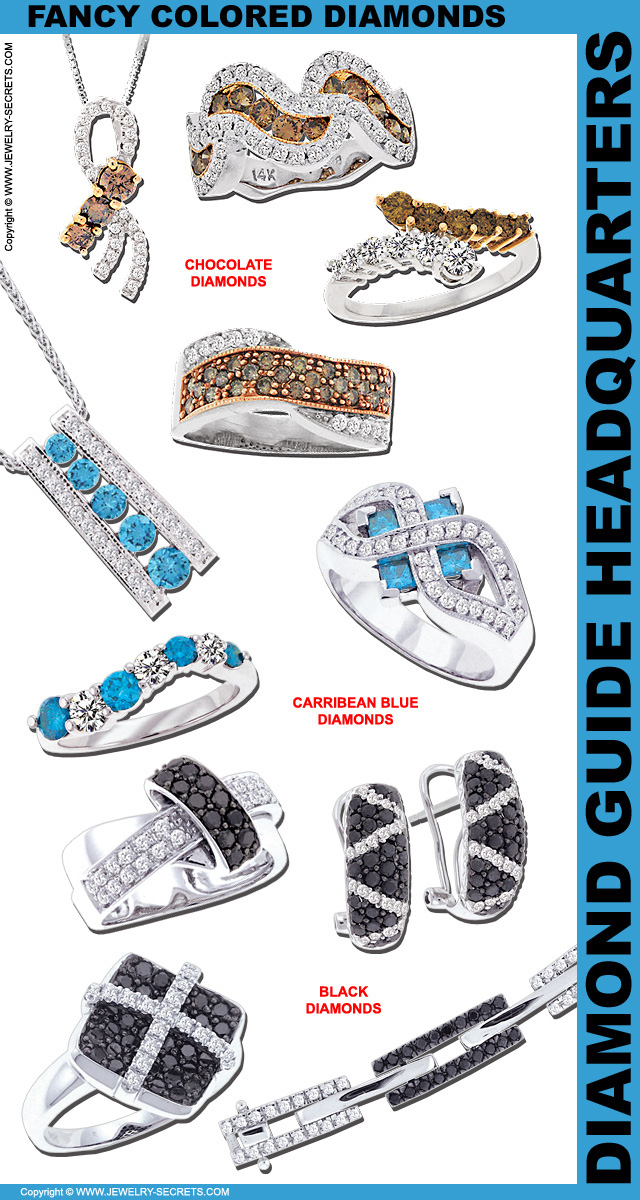
The Rarest Diamond Color:
Pinks, reds and orange colors are the most expensive fancy colors and the most rarest to find. Be prepared to pay a pretty penny for them.
So whether fancy colors are your thing, of if you’d prefer to stick to the whiter shades, like D, E or F, diamonds and color have always been a wonderful topic of discussion, and a wonder of nature itself.
Chocolate Diamonds anyone?
Why not? They’re fat-free. :)
Now onto the next of the 4C’s:
Enjoy!


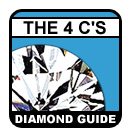
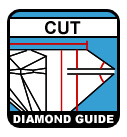
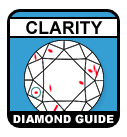
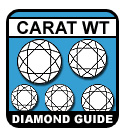
















Leave a comment